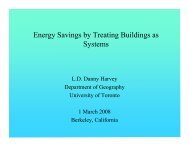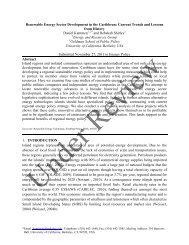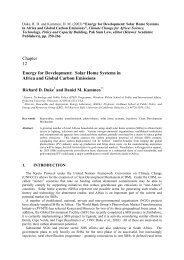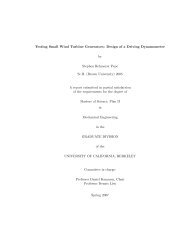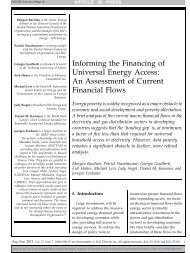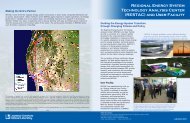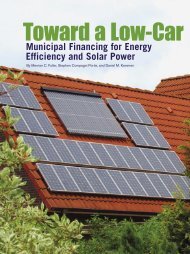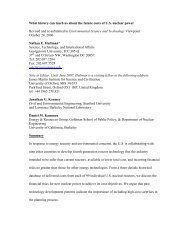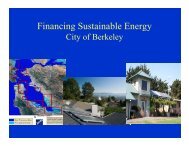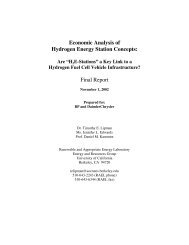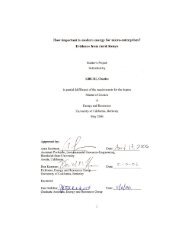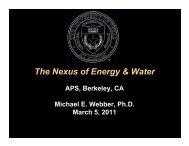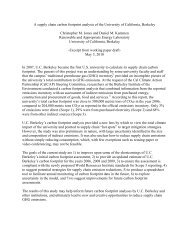Deep carbon reductions in California require electrification and ...
Deep carbon reductions in California require electrification and ...
Deep carbon reductions in California require electrification and ...
You also want an ePaper? Increase the reach of your titles
YUMPU automatically turns print PDFs into web optimized ePapers that Google loves.
Home Search Collections Journals About Contact us My IOPscience<strong>Deep</strong> <strong>carbon</strong> <strong>reductions</strong> <strong>in</strong> <strong>California</strong> <strong>require</strong> <strong>electrification</strong> <strong>and</strong> <strong>in</strong>tegration across economicsectorsThis article has been downloaded from IOPscience. Please scroll down to see the full text article.2013 Environ. Res. Lett. 8 014038(http://iopscience.iop.org/1748-9326/8/1/014038)View the table of contents for this issue, or go to the journal homepage for moreDownload details:IP Address: 128.3.12.235The article was downloaded on 14/03/2013 at 18:34Please note that terms <strong>and</strong> conditions apply.
IOP PUBLISHINGEnviron. Res. Lett. 8 (2013) 014038 (10pp)ENVIRONMENTAL RESEARCH LETTERSdoi:10.1088/1748-9326/8/1/014038<strong>Deep</strong> <strong>carbon</strong> <strong>reductions</strong> <strong>in</strong> <strong>California</strong><strong>require</strong> <strong>electrification</strong> <strong>and</strong> <strong>in</strong>tegrationacross economic sectorsMax Wei 1 , James H Nelson 2 , Jeffery B Greenblatt 1 , Ana Mileva 2 ,Josiah Johnston 2 , Michael T<strong>in</strong>g 3 , Christopher Yang 4 , Chris Jones 2 ,James E McMahon 1 <strong>and</strong> Daniel M Kammen 2,51 Energy Analysis <strong>and</strong> Environmental Impacts Department, Environmental Energy TechnologiesDivision, Lawrence Berkeley National Laboratory, One Cyclotron Road MS 90R-2002, Berkeley,CA 94720-8136, USA2 Energy <strong>and</strong> Resources Group, 310 Barrows Hall #3050, University of <strong>California</strong>, Berkeley,CA 94720-3050, USA3 Itron Inc., 1111 Broadway, Suite 1800, Oakl<strong>and</strong>, CA 94607, USA4 Institute of Transportation Studies, University of <strong>California</strong>, Davis, CA 95616, USA5 Richard & Rhoda Goldman School of Public Policy, University of <strong>California</strong>, Berkeley, 2607 HearstAvenue, Room 308, Berkeley, CA 94720-7320, USAE-mail: Mwei@lbl.gov <strong>and</strong> kammen@berkeley.eduReceived 31 October 2012Accepted for publication 21 February 2013Published 12 March 2013Onl<strong>in</strong>e at stacks.iop.org/ERL/8/014038AbstractMeet<strong>in</strong>g a greenhouse gas (GHG) reduction target of 80% below 1990 levels <strong>in</strong> the year 2050<strong>require</strong>s detailed long-term plann<strong>in</strong>g due to complexity, <strong>in</strong>ertia, <strong>and</strong> path dependency <strong>in</strong> theenergy system. A detailed <strong>in</strong>vestigation of supply <strong>and</strong> dem<strong>and</strong> alternatives is conducted toassess <strong>require</strong>ments for future <strong>California</strong> energy systems that can meet the 2050 GHG target.Two components are developed here that build novel analytic capacity <strong>and</strong> extend previousstudies: (1) detailed bottom-up projections of energy dem<strong>and</strong> across the build<strong>in</strong>g, <strong>in</strong>dustry <strong>and</strong>transportation sectors; <strong>and</strong> (2) a high-resolution variable renewable resource capacity plann<strong>in</strong>gmodel (SWITCH) that m<strong>in</strong>imizes the cost of electricity while meet<strong>in</strong>g GHG policy goals <strong>in</strong>the 2050 timeframe. Multiple pathways exist to a low-GHG future, all <strong>in</strong>volv<strong>in</strong>g <strong>in</strong>creasedefficiency, <strong>electrification</strong>, <strong>and</strong> a dramatic shift from fossil fuels to low-GHG energy. Theelectricity system is found to have a diverse, cost-effective set of options that meet aggressiveGHG reduction targets. This conclusion holds even with <strong>in</strong>creased dem<strong>and</strong> fromtransportation <strong>and</strong> heat<strong>in</strong>g, but the optimal levels of w<strong>in</strong>d <strong>and</strong> solar deployment depend on thetemporal characteristics of the result<strong>in</strong>g load profile. Long-term policy support is found to be akey miss<strong>in</strong>g element for the successful atta<strong>in</strong>ment of the 2050 GHG target <strong>in</strong> <strong>California</strong>.Keywords: energy system model<strong>in</strong>g, renewable energy, long term energy scenarios,electricity system optimization, deep <strong>carbon</strong> reductionS Onl<strong>in</strong>e supplementary data available from stacks.iop.org/ERL/8/014038/mmediaContent from this work may be used under the terms ofthe Creative Commons Attribution 3.0 licence. Any furtherdistribution of this work must ma<strong>in</strong>ta<strong>in</strong> attribution to the author(s) <strong>and</strong> thetitle of the work, journal citation <strong>and</strong> DOI.1. Achiev<strong>in</strong>g the 2050 GHG target<strong>California</strong> has become an <strong>in</strong>ternationally important testbedfor low-cost, low-GHG energy plann<strong>in</strong>g. <strong>California</strong>’s1748-9326/13/014038+10$33.00 1c○ 2013 IOP Publish<strong>in</strong>g Ltd Pr<strong>in</strong>ted <strong>in</strong> the UK
Environ. Res. Lett. 8 (2013) 014038l<strong>and</strong>mark AB32 law m<strong>and</strong>ates a return of State GHGemissions to the 1990 level by 2020, <strong>and</strong> Executive OrderS-3-05 sets a goal for the State to reduce emissions to 80%below this level by 2050 [1, 2] 6 .In this work, we take an <strong>in</strong>tegrated approach <strong>and</strong> evaluateGHG emissions across the electricity, build<strong>in</strong>g, transportation,<strong>and</strong> <strong>in</strong>dustrial sectors—90% of the current total—<strong>and</strong> donot treat agriculture or non-energy based emissions [3].Tak<strong>in</strong>g the 1990 basel<strong>in</strong>e of energy <strong>and</strong> <strong>in</strong>dustry emissionsas 405 million metric tons CO 2 -equivalent (MtCO 2 -eq), an80% reduction gives a 81 MtCO 2 -eq target for <strong>California</strong> <strong>in</strong>2050 [4]. We take a conservative approach by predom<strong>in</strong>antlyus<strong>in</strong>g technologies that exist <strong>in</strong> the marketplace or are beyondthe demonstration stage.Integrated long-term plann<strong>in</strong>g <strong>and</strong> a portfolio of publicpolicies are be<strong>in</strong>g developed to meet GHG targets <strong>in</strong> <strong>California</strong>.Previous work [5–10] has highlighted the electricitysector as key to deep GHG reduction <strong>in</strong> <strong>California</strong>. This studycomplements <strong>and</strong> exp<strong>and</strong>s on previous work by provid<strong>in</strong>ga detailed, bottom-up assessment of electricity dem<strong>and</strong> <strong>and</strong>supply. Load profiles for <strong>in</strong>creased efficiency, vehicle <strong>electrification</strong>,<strong>and</strong> heat<strong>in</strong>g <strong>electrification</strong> are developed as <strong>in</strong>putsto a state-of-the-art variable renewable resource capacityplann<strong>in</strong>g model of the electric power sector. The SWITCHmodel [11–13] is used to explore generation, transmission,<strong>and</strong> storage deployment through 2050 <strong>in</strong> the synchronouswestern North American electricity grid, of which <strong>California</strong>represents roughly one-third of total dem<strong>and</strong>.We f<strong>in</strong>d that meet<strong>in</strong>g the 2050 GHG target is achievable,but <strong>require</strong>s dramatic changes <strong>in</strong> the way <strong>California</strong> produces,delivers, <strong>and</strong> uses energy. Figure 1 shows the cumulativeimpact of measures that can reach the 2050 target (‘CompliantCase’). Figure 2 shows the radical shift <strong>in</strong> overall primaryenergy result<strong>in</strong>g from these measures. Increased efficiency,low-GHG electricity, <strong>electrification</strong> of heat<strong>in</strong>g <strong>and</strong> vehicles,<strong>and</strong> deployment of susta<strong>in</strong>able biofuels reduce emissions tojust under 100 MtCO 2 -eq <strong>in</strong> 2050 (figure 1). Thus additionalelements are <strong>require</strong>d to meet the 81 MtCO 2 -eq target, suchas higher imports of low-GHG biofuels, higher penetration of<strong>electrification</strong> <strong>in</strong> <strong>in</strong>dustry <strong>and</strong> transportation, or sav<strong>in</strong>gs fromenergy conservation (see onl<strong>in</strong>e supplementary material availableat stacks.iop.org/ERL/8/014038/mmedia). Conservationis highlighted <strong>in</strong> sections 2 <strong>and</strong> 3 as an additional elementto atta<strong>in</strong> the 80% target. The electricity sector model<strong>in</strong>g <strong>in</strong>sections 4 <strong>and</strong> 5 does not <strong>in</strong>clude dem<strong>and</strong> reduction fromconservation s<strong>in</strong>ce there are other pathways to meet the 80%target (e.g., the 100 MtCO 2 -eq case above coupled with higherbiofuel imports). Table 1 provides a summary of energydem<strong>and</strong>s <strong>and</strong> emission <strong>in</strong>tensities for build<strong>in</strong>gs, <strong>in</strong>dustry, <strong>and</strong>transportation sectors for 2011 <strong>and</strong> four 2050 cases.2. Transportation <strong>electrification</strong> <strong>and</strong> biofuels arecriticalManag<strong>in</strong>g transportation sector emissions is vital to achiev<strong>in</strong>gthe long-term GHG target as it makes up approximately 40%6 Detailed <strong>in</strong>formation describ<strong>in</strong>g <strong>California</strong> climate programs can befound at www.arb.ca.gov/cc/cc.htm (Climate Change Programs, <strong>California</strong>Environmental Protection Agency, Air Resources Board).M Wei et alof <strong>California</strong> emissions [9]. As dictated by the current statusof technology, two primary pathways are proposed to achievelow-GHG transportation <strong>and</strong> displace petroleum-based fuels:low-GHG biofuels <strong>and</strong> <strong>electrification</strong> 7 . This work does notconsider hydrogen vehicles due to the multiple challengesposed by hydrogen distribution, storage, fuel cell technology,<strong>and</strong> cost, though under certa<strong>in</strong> circumstances this pathwaycould become another viable, low-GHG option for thetransportation sector.In our analysis, all biomass is directed towards biofuelproduction <strong>and</strong> none is made available for electricity, ow<strong>in</strong>gto the difficulty <strong>in</strong> electrify<strong>in</strong>g some transportation modes<strong>and</strong> the relative abundance of low-GHG sources of electricity.In keep<strong>in</strong>g with the technical potential framework used<strong>in</strong> the build<strong>in</strong>g <strong>and</strong> <strong>in</strong>dustry sectors, we adopt 94 milliondry tons of biomass for an overall supply of 7.5 billiongallons gasol<strong>in</strong>e-equivalent <strong>in</strong> 2050 [6]. This biomass scenarioresults from high growth <strong>in</strong> herbaceous <strong>and</strong> forest residues,improved technical yield recovery, substantial <strong>in</strong>vestment<strong>in</strong> additional energy crops, <strong>and</strong> utilization of ab<strong>and</strong>onedagricultural <strong>and</strong> non-productive forest l<strong>and</strong>s. Consistent withState Executive Order S-06-06, 8 we limit imported biofuels to25% of total supply. Still, total biofuels fall short of projectedliquid fuel dem<strong>and</strong> by 32%, necessitat<strong>in</strong>g a shift to electrictransportation.A stock turnover model is used to project lightdutyelectric vehicle deployment, with 45% of passengervehicle miles from electricity <strong>in</strong> 2050. Passenger vehicle<strong>electrification</strong> assumes that plug-<strong>in</strong> hybrid <strong>and</strong> battery electricvehicles quickly enter the market, <strong>and</strong> by 2050 becomethe majority of the fleet. Vehicle sales adoption curves bydrive tra<strong>in</strong> technology are shown <strong>in</strong> figure S6 (supplementarymaterial available at stacks.iop.org/ERL/8/014038/mmedia),<strong>and</strong> recent State policy targets call for similarly aggressivemarket penetration through 2025 [14]. Fixed, nighttime loadprofiles for electric vehicles are developed as <strong>in</strong>puts for theelectric sector model below. 81 000 GWh of dem<strong>and</strong> areadded to the electric power system <strong>in</strong> 2050 from vehicle<strong>electrification</strong> (figure 1(b)). Aviation, mar<strong>in</strong>e transport, <strong>and</strong>most heavy-duty transport are not electrified due to range<strong>and</strong> weight <strong>require</strong>ments, but other modes, <strong>in</strong>clud<strong>in</strong>g someshort-distance trucks, <strong>in</strong>tra-city buses, <strong>and</strong> rail transport arecompletely electrified.3. Bottom-up build<strong>in</strong>g efficiency <strong>and</strong> <strong>electrification</strong>model<strong>in</strong>gNatural gas currently provides most energy for build<strong>in</strong>g<strong>and</strong> <strong>in</strong>dustry heat, so a major shift <strong>in</strong> State energy policies<strong>and</strong> end-use technologies would be <strong>require</strong>d to enable atransition away from fossil fuel <strong>in</strong> these sectors [15–18].For <strong>in</strong>dustry, low <strong>and</strong> medium temperature processes—39%of <strong>in</strong>dustry fuel dem<strong>and</strong>—are electrified by 2050, total<strong>in</strong>g7 See for example http://gov.ca.gov/news.php?id=17472 (Office of GovernorEdmund G Brown, State of <strong>California</strong>, Executive Order B-16-2012).8 Climate Change Programs, <strong>California</strong> Environmental Protection Agency,<strong>California</strong> Air Resources Board, www.arb.ca.gov/fuels/altfuels/<strong>in</strong>centives/eos0606.pdf. Accessed 1 June 2012.2
Environ. Res. Lett. 8 (2013) 014038M Wei et alFigure 1. (a) The <strong>California</strong> 2050 GHG target of 81 MtCO 2 -eq can be met with a comb<strong>in</strong>ation of GHG reduction pathways, each of whichis <strong>in</strong>sufficient on its own. Shown here is a compliant case comb<strong>in</strong><strong>in</strong>g <strong>in</strong>creased efficiency across sectors [28], clean electricity, <strong>electrification</strong>of heat<strong>in</strong>g <strong>and</strong> vehicles, biofuel deployment <strong>and</strong> sav<strong>in</strong>gs from energy conservation. The GHG sav<strong>in</strong>gs percentages associated with eachpathway relative to the previous level of emissions are shown <strong>and</strong> are representative of the sav<strong>in</strong>gs potential for each measure. Note that themagnitude of GHG sav<strong>in</strong>gs for each pathway depends on the presentation order. An assessment of the policy l<strong>and</strong>scape is shown for eachpathway. All pathways lack long-term policy targets, <strong>and</strong> no enabl<strong>in</strong>g policy for heat <strong>electrification</strong> or conservation currently exists.(b) Electricity system dem<strong>and</strong>. Increased efficiency <strong>in</strong> the build<strong>in</strong>g <strong>and</strong> <strong>in</strong>dustry sector can reduce <strong>California</strong>’s 2050 dem<strong>and</strong> from the frozenefficiency case by 35%, <strong>and</strong> conservation can provide a further 16% electricity dem<strong>and</strong> reduction. Increases <strong>in</strong> electricity dem<strong>and</strong> stem from<strong>electrification</strong> of build<strong>in</strong>g heat, <strong>in</strong>dustry process heat<strong>in</strong>g, <strong>and</strong> vehicles.24 000 GWh of additional dem<strong>and</strong> based on analysis ofend-use applications by <strong>in</strong>dustry sector <strong>and</strong> the availabilityof multiple electric-based process heat<strong>in</strong>g technologies.Residential <strong>and</strong> commercial space <strong>and</strong> water heat<strong>in</strong>g arefully electrified by 2050 (figure 1(b)) through a transition tohigh-efficiency heat pump technology.Hourly load profiles for electricity dem<strong>and</strong> from space<strong>and</strong> water heat<strong>in</strong>g <strong>in</strong> build<strong>in</strong>gs are developed based onhistorical heat<strong>in</strong>g load profiles, disaggregated by <strong>California</strong>climate zone, <strong>and</strong> scaled up to displace all rema<strong>in</strong><strong>in</strong>gGHG-<strong>in</strong>tensive heat<strong>in</strong>g dem<strong>and</strong>s with<strong>in</strong> build<strong>in</strong>gs (figure 3).Electricity dem<strong>and</strong> from water <strong>and</strong> space heat<strong>in</strong>g is greatly<strong>in</strong>creased (figure 1(b)), add<strong>in</strong>g 32 000 GWh to the electricityload <strong>in</strong> 2050.In addition to m<strong>in</strong>imiz<strong>in</strong>g fossil fuel dem<strong>and</strong> from theState’s non-electricity energy supply, <strong>in</strong>creased efficiency ofelectrical devices <strong>in</strong> all build<strong>in</strong>gs is also assumed [19, 20].Without <strong>in</strong>creased efficiency, much higher electricity dem<strong>and</strong><strong>and</strong> greater capacity of generation supply would be <strong>require</strong>d.For reference, we consider a ‘frozen efficiency’ case whereefficiency levels are held at present day levels.A bottom-up stock model is used to simulate efficiencyimprovements <strong>in</strong> residential <strong>and</strong> commercial build<strong>in</strong>gs [21,22], achiev<strong>in</strong>g 38% electricity sav<strong>in</strong>gs <strong>in</strong> 2050 relative to3
Environ. Res. Lett. 8 (2013) 014038M Wei et alFigure 2. Primary energy evolution <strong>in</strong> <strong>California</strong> from 2011 <strong>and</strong> 2050 for the compliant case depicted <strong>in</strong> figure 1. Note the dramatic shift <strong>in</strong>energy sources over time, with the percentage of primary energy for electricity doubl<strong>in</strong>g present levels by 2050. Petroleum-based liquid fuelis sharply reduced <strong>and</strong> the fossil fuel fraction of primary energy drops from 90% <strong>in</strong> 2011 to 44% <strong>in</strong> 2050. Primary energy for combustiblefuels (petroleum, natural gas, coal, biomass, biogas) is def<strong>in</strong>ed as the higher heat<strong>in</strong>g value of the fuel prior to combustion, whereas primaryenergy for non-combustible fuels (hydroelectric, nuclear, geothermal, solar, w<strong>in</strong>d) is def<strong>in</strong>ed as the heat content of net electricity generated.Net energy from imports <strong>and</strong> exports of electricity to <strong>and</strong> from <strong>California</strong> are calculated hourly us<strong>in</strong>g the SWITCH model as the fractionimported multiplied by the out-of-State electricity generation m<strong>in</strong>us the fraction exported multiplied by the <strong>in</strong>-State electricity generation.the frozen efficiency case. For exist<strong>in</strong>g build<strong>in</strong>gs, 100% oftechnically feasible opportunities to improve efficiency on aretrofit or ‘replace on burnout’ basis are applied to eligiblebuild<strong>in</strong>gs by 2050 (supplementary material available atstacks.iop.org/ERL/8/014038/mmedia). Energy sav<strong>in</strong>gs fromnew construction is similar to <strong>California</strong> Public UtilitiesCommission <strong>in</strong>itiatives for Zero Net Energy New Constructionbuild<strong>in</strong>gs [23]: 100% of new residential (commercial)build<strong>in</strong>gs achieve at least 35% (30%) electricity sav<strong>in</strong>gs by2025 (2030) compared to 2005 efficiency st<strong>and</strong>ards.Load profiles are synthesized from the mix of end-usedem<strong>and</strong>s <strong>and</strong> technologies us<strong>in</strong>g a load profile database forboth efficiency <strong>and</strong> build<strong>in</strong>g <strong>electrification</strong> [24]. Efficiencyload profiles for 8760 h yr −1 <strong>in</strong> 14 <strong>California</strong> climate zones<strong>and</strong> 20 end-uses are synthesized <strong>and</strong> provided as <strong>in</strong>puts to theelectric sector model.Efficiency sav<strong>in</strong>gs <strong>in</strong> 2050 are dom<strong>in</strong>ated by asmall number of end-uses. For residential build<strong>in</strong>gs, 63%of cumulative efficiency sav<strong>in</strong>gs come from light<strong>in</strong>g,refrigeration, <strong>and</strong> central air-condition<strong>in</strong>g. For commercialbuild<strong>in</strong>gs, just three uses contribute 81% of the sav<strong>in</strong>gs:<strong>in</strong>terior light<strong>in</strong>g, cool<strong>in</strong>g, <strong>and</strong> refrigeration.4. High-resolution electricity sector model<strong>in</strong>gGHG reduction from <strong>electrification</strong> is predicated on a shift tolow-GHG electricity. Despite aggressive efficiency measures,overall electricity dem<strong>and</strong> <strong>in</strong> the compliant case is only 10%lower than the frozen case due to <strong>in</strong>creases from transportation<strong>and</strong> heat<strong>in</strong>g. As a result, drastic but technically feasible shifts<strong>in</strong> the electric power system appear necessary to de<strong>carbon</strong>ize<strong>California</strong>’s energy system.New plants will replace a large fraction of electricitygeneration <strong>in</strong> today’s power system by 2050, represent<strong>in</strong>gan opportunity to transform the State’s current mix of powerplants <strong>and</strong> <strong>in</strong>crease the reliance on low-GHG power sources.Large-scale <strong>in</strong>tegrated plann<strong>in</strong>g us<strong>in</strong>g suitable policies <strong>and</strong><strong>in</strong>vestments is needed to m<strong>in</strong>imize the cost of this transition.In order to leverage the spatial <strong>and</strong> temporal synergiesamong two of the most promis<strong>in</strong>g low-GHG generationtechnologies (solar <strong>and</strong> w<strong>in</strong>d), careful comb<strong>in</strong>ations of<strong>in</strong>vestments are needed to ensure low-GHG, low-cost, <strong>and</strong>reliable electric power. High-quality renewable resources areunevenly distributed both spatially <strong>and</strong> temporally throughoutwestern North America [25]. It is therefore essential to<strong>in</strong>clude the entire western North American synchronous<strong>in</strong>terconnect—the geographic area of the Western ElectricityCoord<strong>in</strong>at<strong>in</strong>g Council (WECC)—<strong>in</strong> an analysis of future<strong>California</strong> low-GHG electricity supply.The SWITCH electric power system plann<strong>in</strong>g modelis used to explore future electricity scenarios with aWECC-wide cap on power sector GHG emissions, reach<strong>in</strong>g80% below the 1990 level <strong>in</strong> 2050. Power sector GHGallowances are implicitly assumed to be tradable acrossWECC. The version of SWITCH used <strong>in</strong> this study m<strong>in</strong>imizesthe cost of produc<strong>in</strong>g <strong>and</strong> deliver<strong>in</strong>g electricity from presentday until 2050 us<strong>in</strong>g a comb<strong>in</strong>ation of exist<strong>in</strong>g grid assets <strong>and</strong>new generation, transmission, <strong>and</strong> storage capacity.Shift<strong>in</strong>g vehicle <strong>and</strong> heat<strong>in</strong>g dem<strong>and</strong> toward electricitywould drastically change seasonal <strong>and</strong> diurnal load profiles(figure 3). By 2050, the load profile exhibits a strong morn<strong>in</strong>gpeak <strong>in</strong> w<strong>in</strong>ter due to added dem<strong>and</strong> from water heat<strong>in</strong>g,as well as a new even<strong>in</strong>g peak throughout the year dueto electric vehicle charg<strong>in</strong>g. In addition, air condition<strong>in</strong>g4
Environ. Res. Lett. 8 (2013) 014038M Wei et alTable 1. Summary table of energy dem<strong>and</strong>s <strong>and</strong> emission <strong>in</strong>tensities for build<strong>in</strong>gs, <strong>in</strong>dustry, <strong>and</strong> transportation sectors for 2011 <strong>and</strong> four 2050 cases. State population is assumed to <strong>in</strong>crease60% to 59.5 million residents <strong>in</strong> 2050 from 37.7 million residents currently.Energy supply Units20112050 frozenefficiency2050<strong>in</strong>creasedefficiencyEnergy Relative emissions <strong>in</strong>tensity relative to current (2011 = 1)2050 <strong>in</strong>creasedefficiency,low-GHGelectricity,<strong>electrification</strong>,biofuelsBuild<strong>in</strong>gs2050 compliant(<strong>in</strong>creasedefficiency,low-GHGelectricity,<strong>electrification</strong>,biofuels,conservation)2050frozenefficiency2050<strong>in</strong>creasedefficiency2050 <strong>in</strong>creasedefficiency,low-GHGelectricity,<strong>electrification</strong>,biofuels2050 compliant(<strong>in</strong>creasedefficiency,low-GHGelectricity,<strong>electrification</strong>,biofuels,conservation)Liquid, solid Tbtu 52 77 54 17 15 1 1 1 1fuelsGaseous fuel Tbtu 710 1 052 735 227 209 1 1 1 1Sum Tbtu 762 1 129 789 244 224Change 48% −30% −69% −8%Electricity GWh 176 500 288 200 178 800 213 400 196 500 1 1 0.12 0.12Change 63% −38% 19% −8%IndustryLiquid, solid Tbtu 496 611 276 130 94 1 1 0.86 0.86fuelsGaseous fuel Tbtu 1 039 1 255 604 322 232 1 1 0.94 0.94Sum Tbtu 1 535 1 866 880 452 325Change 22% −53% −49% −28%Electricity GWh 47 200 81 100 58 400 91 900 66 200 1 1 0.12 0.12Change 72% −28% 57% −28%TransportationLiquid, solidfuelsBgge 21.4 38.5 20.2 10.6 8.8 1 1 0.50 0.50Change 80% −48% −48% −17%Electricity GWh 0 0 0 97 000 80 900 1 1 0.12 0.12Change −17%5
Environ. Res. Lett. 8 (2013) 014038M Wei et alFigure 3. (a) Drastic shifts <strong>in</strong> load profile are seen from the implementation of efficiency (‘post efficiency’ scenario) <strong>and</strong> subsequentaddition of loads from electric vehicles <strong>and</strong> heat<strong>in</strong>g. The compliant case (‘Base Case’) represents the load profile used as an <strong>in</strong>put to theSWITCH model. One peak <strong>and</strong> one median dem<strong>and</strong> day per season are shown <strong>in</strong> the figure for clarity, though the SWITCH model uses sixdays per season for each decadal time step. (b) WECC-wide electricity generation <strong>in</strong> 2050 as dispatched by SWITCH for the frozenefficiency load profile (c) WECC-wide electricity generation <strong>in</strong> 2050 as dispatched by SWITCH for the compliant case from figures 1(b)<strong>and</strong> 3(a). Note the shift from solar to w<strong>in</strong>d power as the amount of efficiency <strong>and</strong> vehicle <strong>and</strong> heat<strong>in</strong>g <strong>electrification</strong> is <strong>in</strong>creased from thefrozen efficiency load profile.loads <strong>in</strong> summer afternoons rema<strong>in</strong> prom<strong>in</strong>ent even after newefficiency measures are <strong>in</strong>troduced, produc<strong>in</strong>g an electricitysystem with high dem<strong>and</strong> periods <strong>in</strong> both summer <strong>and</strong> w<strong>in</strong>ter.We model this load profile separately for each of 50 areaswith<strong>in</strong> WECC for six hours of each of 24 representativedays <strong>in</strong> the decades 2020–2050. Both peak <strong>and</strong> medianload days from each month are represented to ensure thatSWITCH plans for average <strong>and</strong> peak conditions across anentire year. In each modeled hour, dem<strong>and</strong> must be met bythe optimization, as well as capacity <strong>and</strong> operational reservemarg<strong>in</strong> constra<strong>in</strong>ts to ensure system reliability. Results from<strong>in</strong>vestment optimizations are validated us<strong>in</strong>g a full year ofhourly load <strong>and</strong> variable renewable resource data.5. Many cost-effective electricity generation optionsUs<strong>in</strong>g the SWITCH model, we f<strong>in</strong>d that the WECC electricitysystem <strong>in</strong> 2050 has a diverse set of generation options thatcan cost-effectively meet aggressive GHG reduction targets,even with drastic changes <strong>in</strong> load profile shape due toefficiency <strong>and</strong> large vehicle <strong>and</strong> heat<strong>in</strong>g loads (supplementarymaterial available at stacks.iop.org/ERL/8/014038/mmedia).The scenarios explored <strong>in</strong> this study show that variablerenewable resources (w<strong>in</strong>d <strong>and</strong> solar) could economicallycontribute as little as one-third or as much as three-fifthsof generated power with<strong>in</strong> WECC by 2050. Despite theirvariability, both w<strong>in</strong>d <strong>and</strong> solar technologies appear poised tosupply large amounts of <strong>in</strong>expensive, low-GHG electricity tothe WECC power system of the future.The optimal fractions of w<strong>in</strong>d <strong>and</strong> solar deployment area function of the temporal characteristics of the load profile,with <strong>in</strong>creas<strong>in</strong>g vehicle <strong>and</strong> heat<strong>in</strong>g <strong>electrification</strong> favor<strong>in</strong>gw<strong>in</strong>d over solar power (figure 3). As nighttime heat<strong>in</strong>g <strong>and</strong>electric vehicle loads <strong>in</strong>crease, the energy <strong>and</strong> capacity valueof w<strong>in</strong>d power <strong>in</strong>creases relative to that of solar. Increas<strong>in</strong>g6
Environ. Res. Lett. 8 (2013) 014038M Wei et alFigure 4. Average 2050 electricity generation by fuel category, <strong>and</strong> average 2050 power cost (<strong>in</strong> $2007 per MWh) for ten electricityscenarios <strong>in</strong> which WECC-wide power sector emissions are capped at 80% below 1990 levels. The biomass solid CCS scenario <strong>in</strong>cludesfurther GHG <strong>reductions</strong>. The frozen, no <strong>carbon</strong> cap scenario does not <strong>in</strong>clude a cap on GHG emissions. The compliant case (‘Base Case’) isthe start<strong>in</strong>g po<strong>in</strong>t on which other sensitivity scenarios are based. Information on specific scenarios can be found <strong>in</strong> the supplementarymaterial (available at stacks.iop.org/ERL/8/014038/mmedia). The average power cost varies by less than $20 per MWh across GHG-cappedscenarios, <strong>in</strong>dicat<strong>in</strong>g that many low-cost, low-GHG options exist for the power sector.dem<strong>and</strong> flexibility could <strong>in</strong>centivize either w<strong>in</strong>d or solarpower, depend<strong>in</strong>g on their relative delivered costs.Us<strong>in</strong>g operat<strong>in</strong>g reserve <strong>require</strong>ments <strong>and</strong> large balanc<strong>in</strong>gareas similar to those evaluated <strong>in</strong> the Western W<strong>in</strong>d <strong>and</strong>Solar Integration Study [26], we f<strong>in</strong>d that the majority ofsp<strong>in</strong>n<strong>in</strong>g reserves <strong>in</strong> WECC can be provided by hydroelectricpower <strong>and</strong> storage technologies, with the balance providedby gas-fired technologies. Sub-hourly load balanc<strong>in</strong>g does notappear to be a major limitation for achiev<strong>in</strong>g deep emissionsreduction <strong>in</strong> a future electricity grid with up to 60% of energyfrom variable renewable generation.Nuclear power <strong>and</strong> fossil fuel generation with CO 2capture <strong>and</strong> sequestration (fossil/CCS) may be attractivelow-GHG baseload technologies, but neither is essential tomeet<strong>in</strong>g GHG targets (figure 4). With the costs assumed <strong>in</strong>this study, generat<strong>in</strong>g electricity from fossil/CCS can lowerthe cost of power while meet<strong>in</strong>g emissions targets. Installationof new nuclear power is found to be a backstop aga<strong>in</strong>st ris<strong>in</strong>gpower costs, but is not cost-effective given our base costassumptions.Greater fractions of energy from variable renewableresources are found to <strong>in</strong>crease the magnitude of transmission<strong>and</strong> storage deployment (figures S69 <strong>and</strong> S71 availableat stacks.iop.org/ERL/8/014038/mmedia). Power systems <strong>in</strong>this study that generate less than half of their electricityfrom variable renewable resources are not found to needdrastic expansion of the transmission system nor large-scaledeployment of electric energy storage. However, as thefraction of electricity from variable renewable resourcesexceeds fifty per cent, <strong>in</strong>creas<strong>in</strong>g amounts of transmission<strong>and</strong> storage are <strong>in</strong>stalled <strong>in</strong> order to spatially <strong>and</strong> temporallymove electricity from the po<strong>in</strong>t of generation to the po<strong>in</strong>t ofconsumption.The average cost per MWh of electricity stays relativelyconstant between present day <strong>and</strong> 2050 across a range ofcost <strong>and</strong> generator availability scenarios. While this resultis <strong>in</strong> part dependent on technological improvement driv<strong>in</strong>gdecl<strong>in</strong><strong>in</strong>g capital costs, sensitivity analyses show that threefuture supply options with the most uncerta<strong>in</strong> costs—solarphotovoltaics, nuclear, <strong>and</strong> fossil/CCS—are not <strong>in</strong>dividuallyessential to keep the cost of electricity low. In all scenarios,total power system cost <strong>in</strong>creases roughly <strong>in</strong> proportion toload, so while <strong>in</strong>creas<strong>in</strong>g dem<strong>and</strong> adds to total expenditures,the average cost per MWh is stable through 2050. Relative toa scenario <strong>in</strong> which no cap on GHG emissions is enforced,achiev<strong>in</strong>g 80% GHG <strong>reductions</strong> <strong>in</strong> the power sector raises thecost of power by 18%–42%. The tight range of power systemcosts found amongst a variety of scenarios (figure 4) <strong>in</strong>dicatesthat GHG reduction via <strong>electrification</strong> is a robust strategy, asthe risk of power cost overruns is reduced by the availabilityof a portfolio of technologies.6. Discussion—the need for <strong>in</strong>tegrated plann<strong>in</strong>g <strong>and</strong>policyLong-range plann<strong>in</strong>g can ensure that current policies <strong>and</strong>pathways are consistent with long-term goals. Policies thatfocus on improv<strong>in</strong>g natural gas heat<strong>in</strong>g or conventional<strong>in</strong>ternal combustion eng<strong>in</strong>e efficiency without transition<strong>in</strong>gaway from fossil fuel may be appropriate for the shortterm, but are not sufficient for meet<strong>in</strong>g long-term GHGtargets. Similarly, the <strong>electrification</strong> of heat<strong>in</strong>g will only bean effective measure for meet<strong>in</strong>g an 80% reduction goalif the electricity supply has a near zero-GHG <strong>in</strong>tensity.The <strong>in</strong>teraction among different sectors <strong>and</strong> various GHGreductionpathways should cont<strong>in</strong>ue to be an active area ofresearch <strong>and</strong> optimization.Technology does not appear to be the limit<strong>in</strong>g factor forthe State to meet its economy-wide 2050 GHG emissions7
Environ. Res. Lett. 8 (2013) 014038target, though this conclusion is predicated upon amplelow-GHG biomass supplies (with little or no associated<strong>in</strong>direct l<strong>and</strong> use impacts), steady technological development<strong>and</strong> cost reduction of exist<strong>in</strong>g technologies, <strong>and</strong> moremodest economic growth than assumed <strong>in</strong> other studies [5,6]. Much of the technology already exists for <strong>in</strong>creased<strong>electrification</strong> <strong>and</strong> build<strong>in</strong>g efficiency, but may need policysupport to achieve cost-effective production at scale <strong>and</strong>more importantly, to <strong>in</strong>duce widespread adoption (tables S1<strong>and</strong> S2 available at stacks.iop.org/ERL/8/014038/mmedia).Plug-<strong>in</strong> electric vehicles are be<strong>in</strong>g rapidly developed bythe automotive sector, but there is less activity <strong>in</strong> othertransportation sectors. Availability of biomass <strong>and</strong> low-GHGprocess development are pivotal for reduc<strong>in</strong>g fuel-use GHGemissions.In addition to technological solutions, substantial<strong>reductions</strong> are also possible from conservation measures [27].Prelim<strong>in</strong>ary model<strong>in</strong>g of these GHG-sav<strong>in</strong>g measures wasconducted based on historical trends <strong>in</strong> non-energy behaviors<strong>in</strong>clud<strong>in</strong>g public health, safety, <strong>and</strong> diet. By 2050, as much as16% of GHG emissions could be conserved by measures suchas <strong>reductions</strong> <strong>in</strong> vehicle-miles traveled, eco-driv<strong>in</strong>g, <strong>in</strong>creasedenergy conservation, improved diets, waste reduction, <strong>and</strong><strong>in</strong>creased recycl<strong>in</strong>g (section 9, supplementary materialavailable at stacks.iop.org/ERL/8/014038/mmedia). Human<strong>and</strong> social factors should be a topic for further research,as they are directly coupled with public policy, technologydeployment, <strong>and</strong> market development.Expansion of <strong>California</strong>’s policy framework is needed toenable energy system changes suggested here<strong>in</strong>. Aggressivecodes <strong>and</strong> st<strong>and</strong>ards will be <strong>require</strong>d to meet build<strong>in</strong>g, vehicle,<strong>and</strong> <strong>in</strong>dustry efficiency targets. While efficiency is already afocus for the State, implementation <strong>and</strong> adoption of additionalefficiency measures is critical, especially for build<strong>in</strong>g retrofits.Policies are currently <strong>in</strong> place for both vehicle <strong>electrification</strong><strong>and</strong> low-GHG biofuels, but will need extension <strong>and</strong> expansionto meet the 2050 climate goal. Multiple barriers exist forbuild<strong>in</strong>g <strong>electrification</strong>, <strong>and</strong> policy development is urgentlyneeded to ensure the transition to electrified heat<strong>in</strong>g. An 80%reduction <strong>in</strong> electricity sector emissions can be ensured witha cont<strong>in</strong>uation <strong>and</strong> expansion of aggressive renewable energy<strong>and</strong>/or GHG targets <strong>in</strong> the future.Meet<strong>in</strong>g the State’s 2050 GHG target is found tobe feasible but <strong>require</strong>s a portfolio of measures <strong>and</strong> acommitment to <strong>in</strong>tegrat<strong>in</strong>g <strong>and</strong> coord<strong>in</strong>at<strong>in</strong>g policies <strong>in</strong> theelectricity, build<strong>in</strong>gs, transportation, <strong>and</strong> <strong>in</strong>dustrial sectors.The GHG reduction measures put forward here <strong>in</strong>clude an<strong>in</strong>crease <strong>in</strong> the efficiency of energy use for all sectors, adrastic decrease <strong>in</strong> the GHG <strong>in</strong>tensity of electricity <strong>and</strong> liquidfuels, <strong>and</strong> a substitution of end-use fuel consumption forelectricity. Behavioral factors may also be able to play animportant role <strong>in</strong> GHG emission reduction. Long-term policysupport is found to be a key miss<strong>in</strong>g element for the successfulatta<strong>in</strong>ment of the 2050 GHG target <strong>in</strong> <strong>California</strong>.7. Materials <strong>and</strong> methodsFuture electricity <strong>and</strong> fuel dem<strong>and</strong>s were projected forthree economic sectors (build<strong>in</strong>gs, transportation, <strong>and</strong>M Wei et al<strong>in</strong>dustry) with piecewise additive scenarios for energydem<strong>and</strong> <strong>and</strong> energy supply. First, energy efficiency isapplied across sectors, then clean electricity is added,followed by <strong>electrification</strong>, low <strong>carbon</strong> biofuels, <strong>and</strong> thenenergy conservation. Electricity <strong>and</strong> fuel supply mixeswere developed to meet overall dem<strong>and</strong> subject to biofuelavailability <strong>and</strong> GHG constra<strong>in</strong>ts for electricity. GHGemissions were calculated for each scenario based onoverall energy dem<strong>and</strong>s <strong>and</strong> <strong>carbon</strong> <strong>in</strong>tensity of energysupplies. Assumptions for the boundaries <strong>and</strong> scope ofGHG emission treatment are discussed <strong>in</strong> the supplementarymaterial (available at stacks.iop.org/ERL/8/014038/mmedia).Energy dem<strong>and</strong> for a frozen efficiency case was firstestimated as a reference case with growth rates <strong>in</strong>formedby historical trends <strong>and</strong> other studies. An energy efficiencycase was then developed assum<strong>in</strong>g that technical potentiallevels of efficiency are achieved across all three sectors.A low-GHG electricity supply was added to this scenario(energy supply model<strong>in</strong>g is described below). Fuel-switch<strong>in</strong>gwas <strong>in</strong>troduced by assum<strong>in</strong>g wide spread <strong>electrification</strong> fromgasol<strong>in</strong>e-based <strong>in</strong>ternal combustion eng<strong>in</strong>es to electrifiedor partially electrified passenger vehicles <strong>and</strong> from largelynatural gas based heat<strong>in</strong>g processes to electrified heat<strong>in</strong>g<strong>in</strong> build<strong>in</strong>gs <strong>and</strong> <strong>in</strong>dustry. Further <strong>carbon</strong> reduction wasachieved by assum<strong>in</strong>g technical potential availability of liquidbiofuels <strong>and</strong> f<strong>in</strong>ally by assum<strong>in</strong>g conservation measures areaggressively adopted.Energy dem<strong>and</strong> was disaggregated <strong>in</strong>to build<strong>in</strong>g, transportation,<strong>and</strong> <strong>in</strong>dustry sectors for <strong>California</strong>. Estimatesutilized a median population <strong>and</strong> economic growth forecastbased on State <strong>and</strong> <strong>California</strong> Energy Commission (CEC) estimates,respectively. Build<strong>in</strong>g dem<strong>and</strong>s for electricity <strong>and</strong> fuel(e.g., natural gas for heat<strong>in</strong>g) were developed for residential<strong>and</strong> commercial build<strong>in</strong>gs as described <strong>in</strong> the supplementarymaterial (available at stacks.iop.org/ERL/8/014038/mmedia)<strong>and</strong> further disaggregated <strong>in</strong>to s<strong>in</strong>gle/multi-family units <strong>and</strong>new/exist<strong>in</strong>g build<strong>in</strong>gs. Stock turnover analysis was donefor a comprehensive set of end-use dem<strong>and</strong>s. Commercialbuild<strong>in</strong>gs dem<strong>and</strong> estimates utilized historical trends ofenergy dem<strong>and</strong> per square foot of space by build<strong>in</strong>g type.Electricity dem<strong>and</strong> for the rest of the Western ElectricityCoord<strong>in</strong>ation Council geographic region was estimated from asynthesis of US Energy Information Adm<strong>in</strong>istration data <strong>and</strong>regional utility forecasts.Transportation dem<strong>and</strong> estimates utilized vehicle stockmodel<strong>in</strong>g for passenger vehicles <strong>and</strong> aviation with projectionsfor other transportation modes consistent with State orfederal models. Stock model<strong>in</strong>g assumptions of vehiclesper capita, vehicle-miles travelled (VMT) per vehicle, <strong>and</strong>market penetrations by vehicle drivetra<strong>in</strong> (<strong>in</strong>ternal combustioneng<strong>in</strong>es, hybrid electric vehicles, plug-<strong>in</strong> hybrid vehicles, <strong>and</strong>battery electric vehicles) are described <strong>in</strong> the supplementarymaterial (available at stacks.iop.org/ERL/8/014038/mmedia).Industry dem<strong>and</strong> estimates employed sector-based (oil <strong>and</strong>gas, food <strong>and</strong> beverage, etc) economic growth projectionsfrom the CEC.The energy efficiency scenario utilized technical potentialestimates for each sector. The build<strong>in</strong>g sector employed8
Environ. Res. Lett. 8 (2013) 014038a list of over 200 unique efficiency measures whilethe transportation sector adopted fuel efficiency potentialfrom exist<strong>in</strong>g national <strong>and</strong> State studies. Industry technicalpotential estimates were based on CEC reports disaggregatedby <strong>in</strong>dustry sector <strong>and</strong> end-use (process heat<strong>in</strong>g, boiler-basedsystems, motor systems, heat<strong>in</strong>g, ventilation, air-condition<strong>in</strong>g,etc).Electrification projections are based on stock model<strong>in</strong>gfor build<strong>in</strong>g water <strong>and</strong> space heat<strong>in</strong>g <strong>and</strong> for passengervehicles assum<strong>in</strong>g aggressive transition to electricity-basedheat<strong>in</strong>g systems <strong>in</strong> build<strong>in</strong>gs start<strong>in</strong>g <strong>in</strong> 2015 <strong>and</strong> to alternativepassenger vehicles <strong>in</strong> transportation, respectively, with marketpenetration assumptions described <strong>in</strong> the supplementarymaterial (available at stacks.iop.org/ERL/8/014038/mmedia).The <strong>carbon</strong> sav<strong>in</strong>gs potential for energy conservationwas estimated us<strong>in</strong>g a simple adoption rate model of energysav<strong>in</strong>g actions. From a database of historical non-energyactions, long-term adoption rates were estimated for a setof conservation actions <strong>in</strong> home energy usage <strong>and</strong> passengervehicle mile reduction, as well as a number of other measures<strong>in</strong> diet, recycl<strong>in</strong>g, <strong>and</strong> consumption. Carbon sav<strong>in</strong>gs asa function of time were estimated by calculat<strong>in</strong>g <strong>carbon</strong><strong>in</strong>tensities for electricity (CO 2 /kWh) <strong>and</strong> transportation(CO 2 /VMT).Low-GHG electricity model<strong>in</strong>g utilized a high-resolutionvariable renewable resource capacity plann<strong>in</strong>g model(SWITCH) of the <strong>in</strong>terconnected Western North Americangrid. SWITCH used spatially resolved, time-synchronizedhourly solar, w<strong>in</strong>d, <strong>and</strong> dem<strong>and</strong> data to explore future low<strong>carbon</strong> electricity scenarios. Optimizations m<strong>in</strong>imized thecost of power between present day <strong>and</strong> 2050 while subjectto reliability <strong>and</strong> policy constra<strong>in</strong>ts. Carbon emissions wereconstra<strong>in</strong>ed to reach 80% below 1990 levels <strong>in</strong> the year 2050.Biofuel supply estimates were made with all biomassdirected to liquid biofuels <strong>and</strong> resultant biofuel assumed toreplace oil-based liquid fuel. Biomass <strong>and</strong> biofuel availabilityprojections utilized technical potential assumptions for <strong>in</strong>-State biomass supply, biomass supply mix, biofuel yield, <strong>and</strong>life-cycle <strong>carbon</strong> emission associated with biofuel production.Biofuel production was assumed to replace gasol<strong>in</strong>e <strong>in</strong>the transportation sector. Sources for biomass materialsavailability <strong>in</strong>clude earlier reports from Oak Ridge NationalLaboratory, the University of <strong>California</strong>, Berkeley, <strong>and</strong> theUniversity of <strong>California</strong>, Davis.All methods <strong>and</strong> key assumptions are described morefully <strong>in</strong> the supplementary material available onl<strong>in</strong>e at (stacks.iop.org/ERL/8/014038/mmedia) .AcknowledgmentsWe thank the <strong>California</strong> Energy Commission for support. Thispaper reflects the views of the authors <strong>and</strong> does not necessarilyreflect the view of the <strong>California</strong> Energy Commission or theState of <strong>California</strong>. DMK thanks the Class of 1935 of theUniversity of <strong>California</strong>, Berkeley, <strong>and</strong> the Karsten FamilyFoundation.None of the authors have a conflict of <strong>in</strong>terest for thiswork.ReferencesM Wei et al[1] Commission of European Communities 2007 Limit<strong>in</strong>g GlobalClimate Change to 2 Degrees Celsius: The Way Ahead for2020 <strong>and</strong> Beyond (available at http://eur-lex.europa.eu/LexUriServ/site/en/com/2007/com2007 0002en01.pdf,accessed 1 July 12)[2] <strong>California</strong> Institute for Energy <strong>and</strong> Environment 2012<strong>California</strong> Vulnerability <strong>and</strong> Adaption Study (available athttp://uc-ciee.org/climate-change/california-vulnerability<strong>and</strong>-adaptation-study,accessed 1 August 12)[3] Jackson S 2009 Parallel pursuit of near-term <strong>and</strong> long-termclimate mitigation Science 326 526–7[4] <strong>California</strong> Environmental Protection Agency Air ResourcesBoard 2012 <strong>California</strong> Greenhouse Gas Inventory for 1990(available at www.arb.ca.gov/cc/<strong>in</strong>ventory/pubs/reports/appendix a1 <strong>in</strong>ventory ipcc sum 1990.pdf, accessed10 June 12)[5] Williams J H, DeBenedictis A, Ghanadan R, Mahone A,Moore J, Morrow W R III, Price S <strong>and</strong> Torn M S 2012 Thetechnology path to deep greenhouse gas emissions cuts by2050: the pivotal role of electricity Science 335 53–9[6] <strong>California</strong> Council on Science <strong>and</strong> Technology 2011<strong>California</strong>’s Energy Future—The View to 2050 (available athttp://ccst.us/publications/2011/2011energy.pdf, accessed1 July 12)[7] Long J C S 2011 Piecemeal cuts won’t add up to radical<strong>reductions</strong> Nature 478 429[8] European Climate Foundation 2010 ROADMAP 2050: APractical Guide to a Prosperous, Low-GHG Europe(available at www.roadmap2050.eu, accessed 1 July 12)[9] Yang C, Ogden J M, Sperl<strong>in</strong>g D <strong>and</strong> Hwang R 2011<strong>California</strong>’s Energy Future: Transportation Energy Use <strong>in</strong><strong>California</strong> (Sacramento, CA: <strong>California</strong> Council on Science<strong>and</strong> Technology) (available at http://ccst.us/publications/2011/2011transportation.pdf, accessed 1 July 2012)[10] Jacobson M Z <strong>and</strong> Delucchi M A 2011 Provid<strong>in</strong>g all globalenergy with w<strong>in</strong>d, water, <strong>and</strong> solar power, part I:technologies, energy resources, quantities <strong>and</strong> areas of<strong>in</strong>frastructure, <strong>and</strong> materials Energy Policy 39 1154–69[11] Fripp M 2008 Optimal <strong>in</strong>vestment <strong>in</strong> w<strong>in</strong>d <strong>and</strong> solar power <strong>in</strong><strong>California</strong> PhD Dissertation University of <strong>California</strong>Energy <strong>and</strong> Resources Group[12] Nelson J, Johnston J, Mileva A, Matthias Fripp M, Hoffman I,Petros-Good A, Blanco C <strong>and</strong> Kammen D M 2012High-resolution model<strong>in</strong>g of the western North Americanpower system demonstrates low-cost <strong>and</strong> low-GHG futuresEnergy Policy 43 436–47[13] Fripp M 2012 SWITCH: a plann<strong>in</strong>g tool for power systemswith large shares of <strong>in</strong>termittent renewable energy Environ.Sci. Technol. 46 6371–8[14] State of <strong>California</strong> 2013 ZEV Action Plan A Roadmap Toward1.5 Million Zero-Emission Vehicles on <strong>California</strong>Roadways by 2025 First Edition (Governor’s InteragencyWork<strong>in</strong>g Group on Zero-Emission Vehicles, Office ofGovernor Edmund G Brown Jr) (available at http://opr.ca.gov/docs/Governor’s Office ZEV Action Plan (02-13).pdf, accessed 19 February 13)[15] Schmidt P S 1984 Electricity <strong>and</strong> Industrial Productivity, ATechnical <strong>and</strong> Economic Perspective (New York, NY:Pergamon)[16] Electric Power Research Institute 2009 The Potential toReduce CO 2 Emissions by Exp<strong>and</strong><strong>in</strong>g End-UseApplications of Electricity EPRI Report 1018871[17] US Department of Energy 2007 Improv<strong>in</strong>g Process Heat<strong>in</strong>gSystem Performance: A Sourcebook for Industry 2nd edn(Golden, CO: US Department of Energy IndustrialTechnologies Program <strong>and</strong> Industrial Heat<strong>in</strong>g EquipmentAssociation)9
Environ. Res. Lett. 8 (2013) 014038[18] Greenblatt J, Wei M <strong>and</strong> McMahon J 2012 <strong>California</strong>’sEnergy Future: Build<strong>in</strong>gs <strong>and</strong> Industrial Energy Efficiency(Sacramento, CA: <strong>California</strong> Council on Science <strong>and</strong>Technology) (available at http://ccst.us/publications/2011/CEF%20<strong>in</strong>dex.php, accessed 15 February 2013)[19] Masanet E et al 2013 Estimation of Long-TermEnergy-Efficiency Potentials for <strong>California</strong> Build<strong>in</strong>gs <strong>and</strong>Industry (Public Interest Energy Research Program Report,Draft Report) (Sacramento, CA: <strong>California</strong> EnergyCommission)[20] Rufo M W <strong>and</strong> North A S 2007 Assessment of Long-TermElectric Energy Efficiency Potential <strong>in</strong> <strong>California</strong>’sResidential Sector (PIER Energy-Related EnvironmentalResearch Report Report No CEC-500-2007-002)(Sacramento, CA: <strong>California</strong> Energy Commission)[21] Itron, Inc. 2008 <strong>California</strong> Energy Efficiency Potential StudyCALMAC Study ID: PGE0264.01 (available at www.calmac.org/startDownload.asp?Name=PGE0264 F<strong>in</strong>alReport.pdf&Size=5406KB, accessed 1 July 2012)[22] Palmgren C, Stevens N, Goldberg M, Barnes R <strong>and</strong>Rothk<strong>in</strong> K 2010 2009 <strong>California</strong> Residential ApplianceSaturation Study (Report No CEC-200-2010-004)(Sacramento, CA: <strong>California</strong> Energy Commission)M Wei et al[23] <strong>California</strong> Public Utilities Commission 2008 <strong>California</strong> LongTerm Energy Efficiency Strategic Plan (available at www.cpuc.ca.gov/NR/rdonlyres/D4321448-208C-48F9-9F62-1BBB14A8D717/0/EEStrategicPlan.pdf, accessed 1 July2012)[24] <strong>California</strong> Energy Commission 2006 <strong>California</strong> CommercialBuild<strong>in</strong>g End-Use Survey (Report No CEC-400-2006-005)(Sacramento, CA: <strong>California</strong> Energy Commission)[25] H<strong>and</strong> M M, Baldw<strong>in</strong> S, DeMeo E, Reilly J M, Mai T, Arent D,Porro G, Meshek M <strong>and</strong> S<strong>and</strong>or D (ed) 2012 RenewableElectricity Futures Study (Entire Report) (Report NoNREL/TP-6A20-52409) (Golden, CO: National RenewableEnergy Laboratory) 4 volumes[26] National Renewable Energy Laboratory 2010 Western W<strong>in</strong>d<strong>and</strong> Solar Integration Study (Report NoNREL/SR-550-47434) (Golden, CO: National RenewableEnergy Laboratory)[27] Jones C M <strong>and</strong> Kammen D M 2011 Quantify<strong>in</strong>g <strong>carbon</strong>footpr<strong>in</strong>t reduction opportunities for US households <strong>and</strong>communities Environ. Sci. Technol. 45 4088–95[28] Sullivan D, Wang D <strong>and</strong> Bennett D 2011 Essential to energyefficiency, but easy to expla<strong>in</strong>: frequently asked questionsabout decoupl<strong>in</strong>g Electr. J. 24 56–7010



